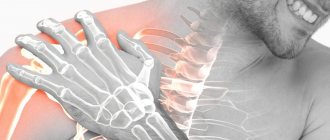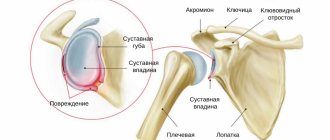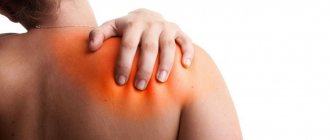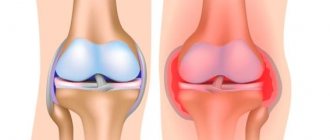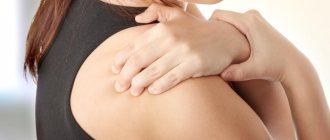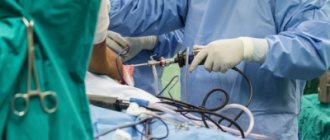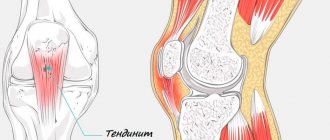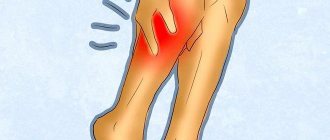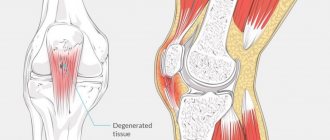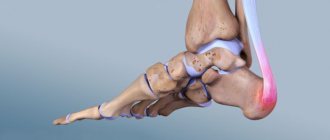The infraspinatus muscle is one of four muscles that make up the rotator cuff (the group of muscles and tendons that provide support to the shoulder). The infraspinatus muscle is almost triangular in shape and is the largest of the rotator cuff muscles and is located in the scapula behind the shoulder. The muscle originates on the shoulder blade, covers the shoulder blade and attaches to the humerus. The main function of the infraspinatus muscle is to externally rotate the shoulder. Damage to the infraspinatus muscle can occur due to overuse or repetitive muscle movements (of the rotator cuff muscles, the infraspinatus muscle, along with the supraspinatus muscle, are the most commonly injured muscles). Playing sports such as baseball, tennis, or swimming that involve intense rotation of the arms can cause injury to the infraspinatus muscle. Activities such as driving or working on a computer without shoulder support can also cause injury to the infraspinatus muscle. Damage or inflammation of the muscle tendons may occur. In some patients, this may be due to impingement syndrome, which occurs when muscle tendons that pass through a narrow space of bone (subacromial) become pinched. Muscle pain syndromes and impaired motor function may be associated with the presence of trigger points in the infraspinatus muscle. Due to the fact that trigger points are inhibitory in nature, there is a decrease in the tone and activity of the shoulder muscles, which leads to a deterioration in stability and motor functionality. The infraspinatus muscle is quite often the culprit of shoulder problems. For normal functioning, any muscle must periodically contract and relax. Without this, movement is impossible. The problem is how often and how well these muscle contractions occur. When muscles have trigger points, they become essentially tight (stiff), similar to a rope that has knots in it, causing it to shorten to its original length. The presence of a trigger point and subsequent tightening of the muscle ultimately leads to decreased range of motion. Trigger points also have a negative impact on the joints, causing them to lose normal mobility. At its core, the body attempts to compensate for abnormal movement, resulting in other areas of stiffness and restricted movement. For example, the desire to stretch is compensatory, which sometimes temporarily relieves discomfort and improves muscle elasticity. But sometimes stretching causes an increase in symptoms.
Muscles in the body do not work in isolation and are connected to each other, and when the body compensatory shifts the load to other muscle groups, due to the presence of problems in one of them, then over time this compensatory mechanism begins to be exhausted, and problems appear in those muscles , which were involved for compensation. In addition, unloading a muscle with problems ultimately leads to the wasting of this muscle and an even greater decrease in its functionality.
When the functionality of the infraspinatus muscle is impaired, stability and range of motion decrease. When the infraspinatus muscle begins to lose tone, the shoulder will then begin to internally rotate.
Further, a cascade of dysfunctional movement disorders arises. The shoulder moves forward and pulls up the chest, and the scapula rotates outward, causing the mid-back muscles to contract. Fatigue accumulates in the muscles, which leads to the drift of the humerus in the socket, resulting in anterior compression on the head of the humerus. As the acromioclavicular mechanics of the shoulder joint is disrupted, the trapezius muscles tighten and lift the shoulder upward. These compensatingly tense muscles can develop their own hidden and satellite trigger points.
Characteristics of Supraspinatus Tendonitis
Tendinitis of the supraspinatus muscle of the shoulder joint is a pathological process that is inflammatory in nature and is not caused by direct injury to this part of the body. The reasons that provoke damage to the muscle tendons in the shoulder area and further inflammatory and degenerative phenomena are excessive and prolonged loads on the proximal segment of the upper limb.
Thus, tendonitis of the supraspinatus muscle of the shoulder joint is localized in the area of contact of the tendon with the bone. This pathology can manifest itself against the background of other similar ailments, which include:
- Inflammatory process in the area where the tendon joins the bone (enthesitis);
- The presence of inflammation in both the tendon area and the location of the bursa (tenosynovitis);
- Localization of the pathological process in the area of the bursae and articular cavities located in close proximity to the tendon.
As a rule, tendinitis of the supraspinatus muscle of the shoulder joint occurs after an inflammatory disease of the synovium or is preceded by bursitis.
Stages of impingement syndrome
There are three stages of impingement syndrome, if you focus on the state of pathological processes. The first is swelling. It usually occurs in the early stages of the disease, mainly at a young age and more often after exercise. The second is fibrosis. This is a problem of middle age and longer duration of the disease. The third is the formation of bone growths. In the last two stages, partial or complete tendon ruptures and other complications occur.
There is another classification.
The early stage of impingement syndrome is characterized by limitation of movements, discomfort and even pain, but there are still no changes in the bones and tendons. This stage is called the stage of functional impairment. Over time, the changes that we talked about above appear in the bones, muscles and tendons, and then it is considered that the stage of structural changes has begun.
At the early stage of impingement syndrome, neither MRI nor ultrasound will show anything. During this period, pathology can only be determined by a chiropractor - a neurologist using special muscle tests. If impingement syndrome of the shoulder joint is detected on MRI, then we are talking about the stage of structural changes.
Factors and mechanism of development of supraspinatus tendinitis
Tendinitis of the supraspinatus tendon can occur against the background of the following negative factors:
- Increased load on the shoulder joint;
- Osteochondrosis in the cervical region;
- Rachiocampsis;
- Incorrect posture;
- Shoulder injury;
- Surgical intervention in the cervical spine or shoulder joint;
- Pathological processes of an autoimmune nature, which include rheumatoid arthritis;
- Postmenopausal women (over 50 years old);
- Infectious diseases caused by the presence of gonorrhea pathogens or other pathogenic bacteria;
- Persons of the elderly age group (over 60 years old).
Also, the reasons that provoke the development of tendinitis of the supraspinatus tendon include stressful situations and exposure to thermal irritants.
The mechanism of progression of tendinitis of the supraspinatus muscle of the shoulder is determined by the factors that provoke it:
| Negative factors | Development mechanism |
| Increased load on the shoulder joint | Frequent microtraumas lead to inflammatory processes. |
| Osteochondrosis in the cervical region Incorrect posture Surgery in the neck and shoulder area | Mobility of the shoulder joint worsens. This negatively affects the condition of the tendon and increases it. The likelihood of microtraumas that provoke a pathological process. |
| Infectious processes, autoimmune diseases, rheumatism | Due to weakening of the immune system, excessive production of antibodies occurs. This leads to the destruction of the tendons and, as a result, tendonitis of the supraspinatus tendon of the shoulder joint. |
| Older men Women during menopause | Tendons lose elasticity. Even small loads lead to microtrauma and further pathological processes. |
This pathology may be accompanied by degenerative disorders in the tendon area and adhesions in the tissues immediately surrounding the joint.
Symptoms of supraspinatus tendinitis
Next, we will look at the characteristic signs of the disease depending on the stages of the inflammatory process in the area of the tendon of the shoulder joint.
Stage 1. This stage of pathology is characterized by the following manifestations:
- Painful sensations of slight intensity that disappear after rest;
- They occur mainly during the period of physical activity, mainly during rotation of the joint, as well as lifting and stretching the upper limb forward;
- The appearance of mild pain when lifting a limb upward, as well as when putting on and taking off clothes;
- Discomfort during night sleep: when throwing a limb over the head or prolonged pressure on it;
- The shoulder joint does not lose its usual mobility.
Stage 2. Characterized by the following features:
- Painful sensations become more intense, which limits the natural motor process;
- The person loses the ability to fully lift the upper limb or extend it in front of him;
- The pain syndrome makes itself felt exclusively during physical activity and disappears during the period of rest;
- Discomfort occurs when squeezing the hand, lifting small objects, or shaking hands;
- The appearance of an uncharacteristic crunching sound during physical activity.
Stage 3. Has the following symptoms:
- In severe form, pain syndrome manifests itself both during physical activity and during rest;
- The duration of the attack reaches 6-8 hours;
- Pain sensations can radiate not only to the shoulder joint area, but also to the elbow area;
- Significant limitation of joint mobility.
Prevention
Prevention of impingement syndrome of the shoulder joint and supraspinatus muscle syndrome consists of proper ergonomics of the workplace, full physical activity and, most importantly, maintenance and care of your body. Most people perceive the concept of “body care” only in the context of hygiene. But, for some reason, “car care” is always perceived correctly – both cleanliness and maintenance. In general, our body, like a car, also needs maintenance. And here there is no need to be mistaken about fitness and sports - this is not maintenance, but other modes of operation. They make physical activity complete, as mentioned above, but do not at all replace “technical” care from a doctor. The ideal type of prevention of impingement syndrome and supraspinatus syndrome is gentle manual therapy. It is radically different from conventional manual therapy in its gentleness and effectiveness. It includes a large number of soft types of therapeutic and preventive effects aimed at the spine, muscles and joints. As a preventive measure, it is enough to conduct one session every six months to prevent not only impingement syndrome, but also many other pathologies of the spine, muscles and joints.
In conclusion, I would like to say, no matter how things are, even in advanced cases of impingement syndrome and the need for its surgical treatment, there is no need to despair. The prospects for treatment and recovery are very good. The main thing is not to give up and act.
Treatment of tendinitis of the supraspinatus muscle of the shoulder joint
Tendinitis of the supraspinatus tendon is characterized by a chronic course. It is possible to completely cope with the disease only if it is detected in a timely manner at the initial stage and strictly follows the recommendations of a specialist.
If supraspinatus tendonitis was diagnosed at the second stage, it is unlikely to achieve a 100% treatment result, especially if there is an accumulation of calcium formations in the tissues. But it is quite possible to increase the mobility of the shoulder joint and relieve pain at this stage of the disease.
If the signs of the disease are ignored, it can develop into an advanced form, which is accompanied by a complete loss of motor activity in the shoulder joint. In such situations, the only highly effective treatment method is surgery. But we should not forget about the long period of rehabilitation after surgery (can reach 3 months).
As for the initial stages of tendonitis of the supraspinatus muscle of the shoulder joint, at these stages conservative treatment may well give the expected effect.
It should be noted that in order to achieve a successful result with tendinitis of the supraspinatus muscle, it is better to focus on complex treatment, which involves the following measures:
- Lifestyle changes;
- Performing special therapeutic exercises;
- Use of medications;
- Compliance with dietary nutrition;
- Carrying out physiotherapeutic activities.
If a patient is diagnosed with advanced supraspinatus tendinitis, treatment involves surgical intervention.
SWT for supraspinatus tendonitis
The shock wave method is particularly effective in eliminating this disease. This is a modern way to combat many pathological processes, which include calcific tendinitis of the supraspinatus tendon. In this case, it is possible to avoid surgical intervention and also obtain the following beneficial effects:
- It is possible to crush calcium formations in the tendons;
- Blood circulation improves;
- The pain syndrome gradually disappears;
- Metabolism is restored;
- It is possible to quickly cope with inflammation;
- Motor activity is normalized and tissue regeneration occurs.
The patient has the opportunity to achieve a successful and prolonged therapeutic result from the first sessions. Their frequency and frequency are determined individually. Even calcific tendinitis of the supraspinatus tendon can be cured using this technique, but the success of the procedures performed in 90% of situations is determined by the timeliness of a visit to a specialist.
In our medical center, highly qualified specialists who are fluent in the shock wave technique and use innovative Swiss equipment in their work will work with you. In this case, the first consultation with a doctor is carried out with a 20% discount.
Medications for supraspinatus tendinitis
Taking into account the results of the research, the specialist selects medications to cope with unwanted symptoms and eliminate the dangerous consequences of the disease. Below we provide a list of drugs that show effectiveness in treating supraspinatus tendinitis. These include:
.
| Group of drugs | Therapeutic effect | Method of application |
| Anti-inflammatory drugs - Nimesulide, Dolgit, Ibuprofen, Voltaren. | They help eliminate swelling, relieve pain and cope with inflammation. | It is recommended to use it in the form of capsules, tablets, as well as gels and ointments. |
| Medicines that have an analgesic effect - Dexalgin, Ketonal. | They have the ability to eliminate severe pain. | Used in the form of intramuscular injections and in tablet form. |
| Drugs that prevent the destruction of cartilage tissue - Teraflex, Artra. | They allow you to restore cartilage tissue and prevent destructive-dystrophic processes in the joints. | Prescribed in tablet form. |
It should be remembered that tendinitis of the supraspinatus and subscapularis muscles requires a qualified approach, and only a professional specialist can give recommendations on taking certain medications.
We employ high-level physiotherapists who approach problems with tendons and joints in a comprehensive manner, taking into account the individual characteristics of the progression of the disease.
How to treat supraspinatus tendinitis through physical therapy?
In order to increase the effectiveness of the treatment methods used, they resort to physiotherapeutic procedures. With their help, it is possible not only to cope with the signs of pathology, but also to increase the effectiveness of medications, as well as restore normal blood flow and improve cell nutrition.
At the same time, the most effective physical procedures include:
- Exposure to shock waves (SWI). It is considered a highly effective way to eliminate calcific tendonitis of the supraspinatus muscle of the shoulder joint;
- Application of ultrasound. Allows you to eliminate swelling and prevent the appearance of adhesions;
- Electrophoresis. Ensures precise delivery of medications to the inflamed area;
- Use of laser radiation. Promotes the restoration of tendon fibers;
- Magnetotherapy. Allows you to normalize nutrition and blood flow in the affected area.
It should be borne in mind that physiotherapeutic methods of influence can be used only after acute processes have been eliminated.
Massotherapy
Restorative massage is recommended to eliminate pain. It allows you to relax muscle tissue and normalize metabolism. To achieve maximum results, it is recommended to undergo at least 15 procedures.
Dietary recommendations
When it comes to supraspinatus tendinitis and how best to treat it, the first step is to adjust your diet. Its principles should be aimed at strengthening tendons.
| It is advisable to use | Not recommended for use |
| Beef meat, liver, fish | Sweet products, fast food |
| Eggs and dairy products containing beneficial bacteria | Carbonated drinks |
| Nuts, apricots, dried fruits | Alcoholic drinks |
| Lemons, oranges | Oatmeal |
| Green tea |
Products recommended for consumption during the period of elimination of supraspinatus tendinitis contain large amounts of vitamins, as well as calcium, iodine, phosphorus and iron. This ensures rapid restoration of the elasticity and strength of the tendon.
In turn, prohibited products contribute to the rapid destruction of joints and tendons, and block the penetration of valuable substances.
Surgical treatment of supraspinatus tendonitis
If we talk about such a serious illness as tendonitis of the supraspinatus muscle of the shoulder joint, and how to treat it, then conservative methods are mainly used. Surgical methods are used in extreme situations, in case of tendon rupture. In this case, arthroscopic intervention is performed to minimize the risk of tissue injury. During this operation, pathological tissue is cut off, plastic procedures are performed with further strengthening of the tendon. A prerequisite after surgery is the implementation of rehabilitation measures.
Recommended Exercises
The need for therapeutic exercises is caused by the following goals:
- Maintain motor activity of the joint;
- Restore and increase the elasticity of the tendon.
In this case, it is recommended to perform the following exercises:
- Rocking the limb back and forth;
- Raising your clasped hands above your head. Number of repetitions – 5 times;
- The right arm, located in a straight position, must be pulled to the shoulder joint located on the opposite side. The exercise is done in a similar way with the left limb;
- Both upper limbs are brought behind the back and connected into a lock, held in this position for about 10-15 seconds. When repeating, change the position of the hands;
- Using a gymnastic stick held in your hands parallel to the floor, you perform circular movements in the air. The total number of repetitions is 5 times;
To choose the most effective exercises, it is advisable to consult your doctor, who will select a special complex taking into account the degree of pathology. In case of acute pain, gymnastic exercises are not recommended.
Traditional methods
To eliminate the symptoms of the disease, you can use recipes whose effectiveness has been proven for centuries. They are aimed at increasing the strength of the tendon, improving its motor activity and relieving pain.
Below we will describe several folk methods that allow you to relieve the inflammatory process:
- Walnut partitions. 1 glass of product is filled with 0.250 liters of vodka. The infusion period reaches 21 days. The mixture is taken one tablespoon 3 times a day;
- Calendula flowers. The dried raw materials are crushed and 1 liter of vodka is added. The infusion time is 7 days. Compresses with this solution are applied to the affected joint. This helps to quickly relieve discomfort.
Lifestyle change
Experienced experts advise:
- Avoid excessive stress on the upper limb and shoulder joint, avoid lifting heavy objects and active physical training. At the same time, it is not recommended to reduce the usual motor activity of the joint;
- Avoid hypothermia. When exposed to any thermal irritants, the intensity of pain in muscles and joints may increase;
- It is also necessary to stop drinking alcohol and using tobacco products, as this negatively affects the functioning of the entire body, including the shoulder joint.
Preventive actions
As you know, it is better to prevent pathology than to treat it for a long time.
Thus, in order to exclude pathological processes in this area, the following useful recommendations should be followed:
- Regularly perform physical exercises aimed at increasing the strength of ligaments and muscles;
- Warm up before any physical activity;
- It is necessary to ensure optimal load;
- Increasing the intensity of loads should occur smoothly.
It is also recommended to visit a specialist as a preventive measure. The success of the treatment measures is influenced, first of all, by strict adherence to the doctor’s instructions.
Treatment of impingement syndrome
Treatment of impingement syndrome can be both surgical and non-surgical, and treatment of supraspinatus muscle syndrome is only non-surgical.
Treatment of supraspinatus muscle syndrome is divided into primary and auxiliary. The main methods include gentle manual therapy. It is fundamentally different from conventional manual therapy in its softness, safety and high efficiency. Auxiliary methods include massage, medicinal treatment and physiotherapy.
In the non-surgical treatment of impingement syndrome, as well as in the treatment of supraspinatus muscle syndrome, gentle manual therapy has proven itself to be very effective. Massage, physiotherapy and medications are also used as auxiliary therapeutic methods. Surgical treatment involves a series of actions aimed at eliminating the negative impact of the acromion on the muscle and tendon.
But, as we have already said, surgical treatment of impingement syndrome should be resorted to only after comprehensive consultations with various specialists and after all therapeutic options have been exhausted.
Forecast
As a rule, a favorable prognosis for eliminating the above ailment depends on the approach of the patient himself. Since tendinitis of the shoulder joint is a common and dangerous pathology, treatment procedures should be started early. That is, as soon as you notice any signs of the disease, you must immediately see a doctor, since even minor discomfort can be fraught with serious complications. Moreover, it is necessary to strictly adhere to the drawn up treatment plan, regularly perform therapeutic exercises, take prescribed medications and do restorative massage.
Unfortunately, if you are inattentive to your own health and the disease progresses to an advanced stage, you risk getting an atrophied and completely devoid of mobility joint.
By contacting our medical center, patients can count on an individual approach to the problem, the use of innovative equipment of European quality, selection of the most effective methods for eliminating supraspinatus tendinitis and affordable prices for services.
